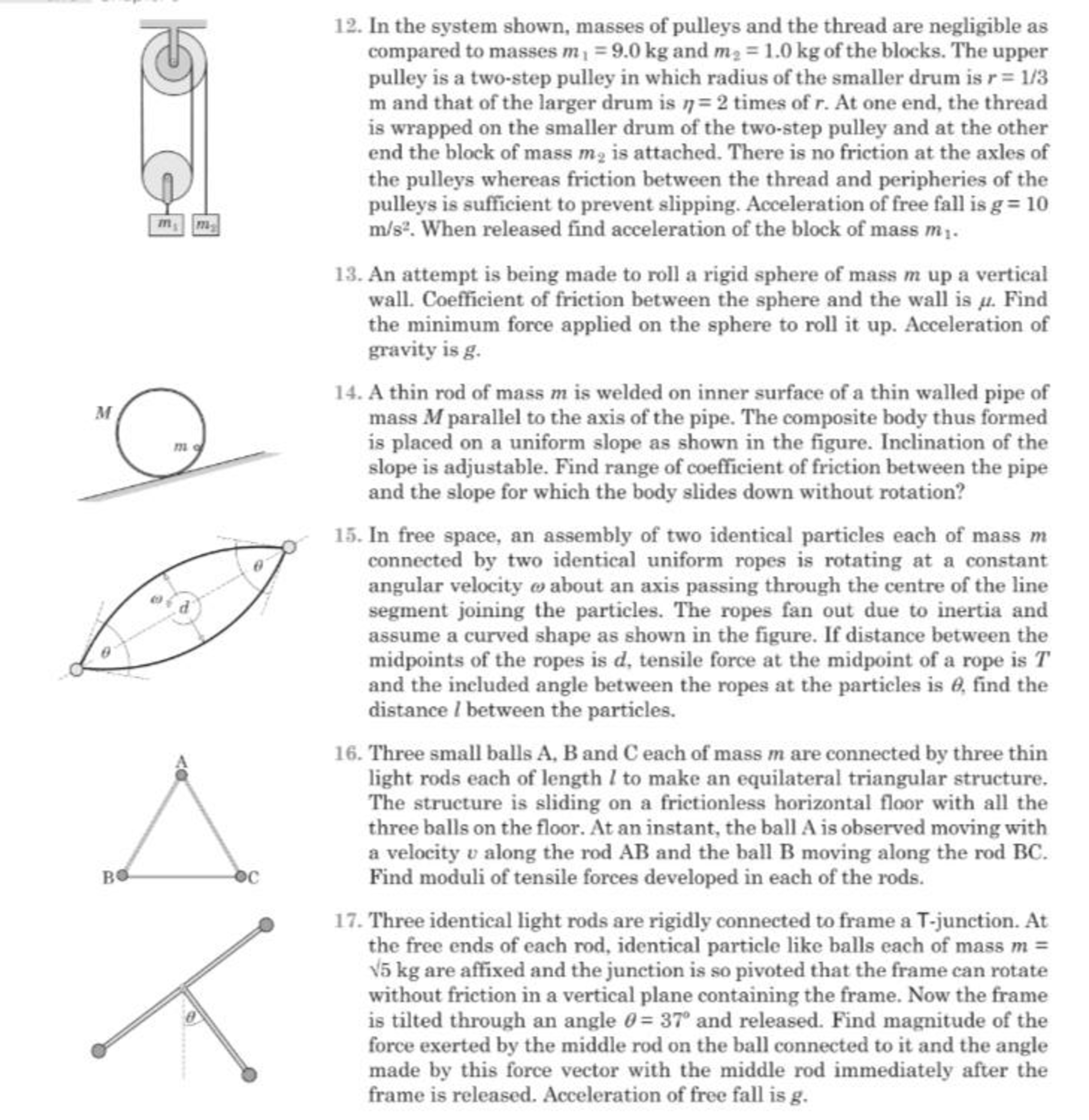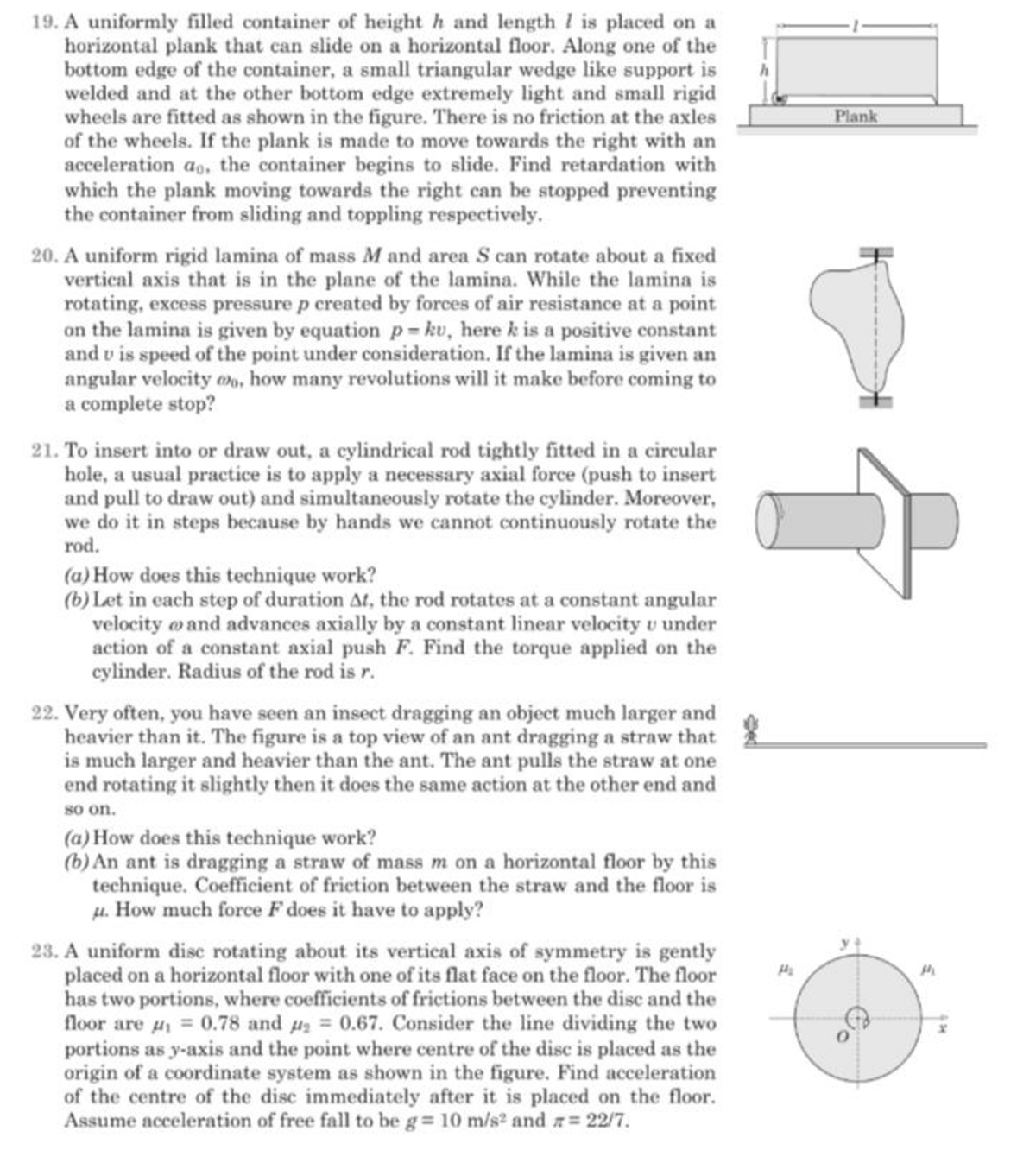Mechanics Doubt HELP!
Here are some problems.if you have solved any one or more please post it's solutions.

The question number are resolved.


If anyone want to see my attempt for a particular problem, they can ask me I will happily show the attempt.
Thanks in advance.
No vote yet
1 vote
Easy Math Editor
This discussion board is a place to discuss our Daily Challenges and the math and science related to those challenges. Explanations are more than just a solution — they should explain the steps and thinking strategies that you used to obtain the solution. Comments should further the discussion of math and science.
When posting on Brilliant:
*italics*or_italics_**bold**or__bold__paragraph 1
paragraph 2
[example link](https://brilliant.org)> This is a quote# I indented these lines # 4 spaces, and now they show # up as a code block. print "hello world"\(...\)or\[...\]to ensure proper formatting.2 \times 32^{34}a_{i-1}\frac{2}{3}\sqrt{2}\sum_{i=1}^3\sin \theta\boxed{123}Comments
Is the answer to problem 27 1.5mg?
Log in to reply
@Karan Chatrath YES
I am even not able to understand what the question wants to say?
Can you help me to understand what it is saying?
Log in to reply
I will post a note later.
@Steven Chase @Karan Chatrath Please sir can you help me.. Thanks in advance.
I'm getting approximately 0.35 for Problem 23. Is that the correct answer?
Log in to reply
@Steven Chase YES
My answer for problem 13 is:
Fmin=49μ2+1mg
Is it correct?
Log in to reply
@Karan Chatrath No. In the answer the coefficient of μ2 is 1 instead of 49.
Log in to reply
I am managing to get that answer but somehow that result is not making sense to me.
Okay, I have now understood the problem. What I did is also not wrong. I analysed a slightly different case.
Log in to reply
@Karan Chatrath Yeah Nice. Can you show the solution?
OR would you like to see my attempt?
Problem 13 solution:
Consider the force F to have a horizontal and vertical component Fx and Fy respectively. Drawing a free body diagram will give you the following equations:
N=Fx Fy−mg−f=ma fR=52mR2α
Now for the sphere to just start rolling upwards, it must just start linearly accelerating. In the limiting case, this happens when a=0 and f=μN. Note that a and α are unrelated. I was initially treating this as a pure rolling problem, but the problem does not specify that. This is a case of 'not pure rolling'. So plugging this understanding into the second equation above gives:
Fy=μFx+mg
Now, the resultant force is:
F=Fx2+Fy2
The force F is minimum when the expression in the square root is minimum. Therefore, we have a constrained minimisation problem. We are required to minimise the following function G:
G(Fx,Fy)=Fx2+Fy2
Such that:
Fy=μFx+mg
Solving this optimisation problem is something you should try yourself. The answer comes out to be:
Fmin=μ2+1mg
Log in to reply
@Karan Chatrath Thanks for the solution.
I am trying to understand it. By the way ,the last 3rd step of your solution seems me incorrect, according to dimension. Isn't it.?
Log in to reply
I have used α for angular acceleration and a for linear acceleration. Both symbols look similar.
Log in to reply
@Karan Chatrath LAST 3rd step sir?
@Karan Chatrath g is a gravitational acceleration and F is a force.?
Log in to reply
Ah, good catch! I meant to define a function G of Fx and Fy. I have modified the solution.
@Karan Chatrath i didn't understand how did you optimised that at the last. Please elaborate the solution. Thanks in advance.
Log in to reply
Maxima and minima problem. Find the minimum value of the function:
G=Fx2+Fy2
Such that: Fy=μFx+mg
Write Fy in terms of Fx and you have a function of Fx only. Do you know the next step?
Log in to reply
@Karan Chatrath Yes i got it. The next step is differentiation and then just squaring.
But the most important thing is the moment of inertia is not used in this problem which seems me bit surprising.
Log in to reply
I used moment of inertia when I treated this problem as a case of pure rolling. That is why I got a factor of 49 multiplied with μ2. But since it is not a pure rolling case, a=Rα and therefore, the moment of inertia dependence is lost.
Log in to reply
@Karan Chatrath Exactly. It means friction is acting in the ball. Thanks By the way try the 14th question.
@Karan Chatrath i didn't understand the solution of this problem
Can you post a very explanatory solution.
After reading word rolling, my brain stops working . :)